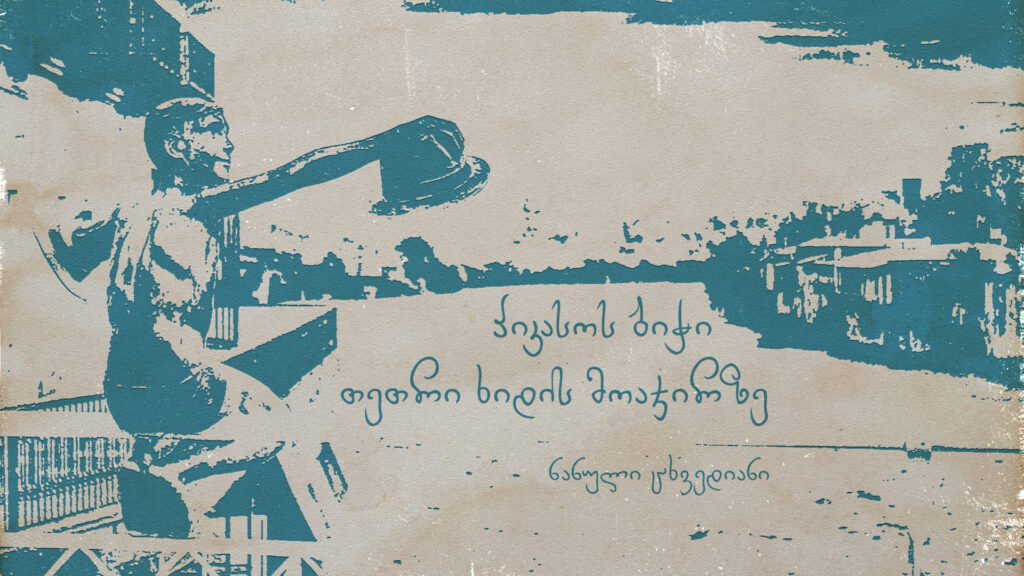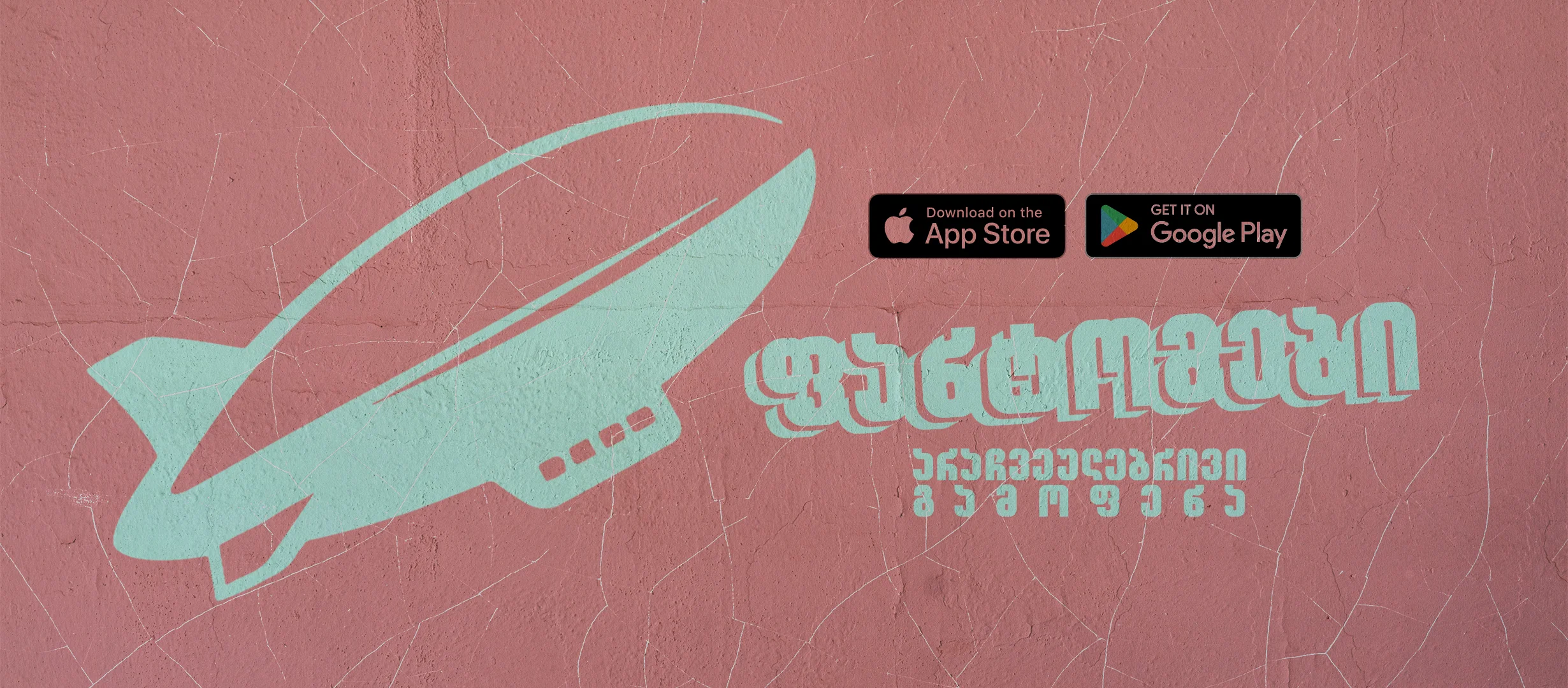
Author: Nanuli Tskhvediani
“Lampreduso – Meduso!..”
An episode from Eldar Shengelaia’s film “An Unusual Exhibition” (1968, screenplay by Rezo Gabriadze):
Actor Shavleg (played by Dodo Abashidze), a man whose mere presence had sparked recognition and amiable greetings, strolled with an air of gentle dignity, responding to each salutation with a courteous nod and a subtle lift of his hat. Beside him walked Aguli Eristavi (played by Guram Lortkipanidze), an artist of profound vision, his eyes scanning the horizon with an artist’s keen perception.
Their conversation flowed like a gentle river, touching upon the many nuances of life and art, until Aguli’s gaze fixed upon a sight that halted his words.
“Shavleg,” he uttered with a sudden intensity, “this is what must be born from my stone! This, the very zenith of existence!”
“Apogee!” echoed Shavleg, his voice tinged with a fervor born of artistic passion.
It was then that Aguli directed Shavleg’s attention to a sight most peculiar – a young boy perched precariously on the railing of the White Bridge. Clad only in his undergarments, the boy sat facing the river, a picture of youthful audacity and charm.
“Behold,” Aguli exclaimed, “a Picasso boy in the flesh! From such as he, I shall draw inspiration.”
The child, sensing their gaze, turned towards them. (The boy was Alika Giorgadi, a 14-year-old Greek boy from Kutaisi who played the role.) His eyes sparkled with a mischievous glint, a sly smile playing briefly upon his lips – a moment immortalized by the astute lens of cinematographer Georgi Gersamia.
“Are you frightened, lad?” inquired Shavleg, his voice laced with a mix of concern and amusement.
“Yes, uncle, I am,” the boy replied, his voice tinged with trepidation.
“Then stand, breathe, close your eyes, and … elle hop!” urged Shavleg, unknowingly setting the stage for the boy’s playful plot.
Quick as a flash, the boy snatched the hats from their heads and, with the grace of a bird, leaped into the Rioni River.
“Swindler!” Shavleg cried out, his anger palpable.
The boy’s voice rang out from the water, triumphant and teasing, “Lampreduso – Meduso! Ale hop!” And with that, he swam away, the stolen hats as his trophies.
Shavleg and Aguli, bereft of their headwear, could only watch from the bridge, a mix of frustration and admiration in their eyes.
“Is this the Picasso boy?” Shavleg exclaimed, his question tinged with a blend of vexation and wonder. “Is this what Picasso dabbles in?”
Shavleg’s question and this entire film episode were imbued with the warm humor and nostalgic charm characteristic of Rezo Gabriadze’s writing. The boy’s antics, devoid of malice, were reminiscent of the playful mischief of youth in Kutaisi, where leaping from bridges and basking in the Rioni’s waves was a rite of passage. His prank, while startling, brought an unexpected spark of joy and novelty into the otherwise steady lives of the two men, a reminder of life’s simple yet profound peaks.
The boy is still on the railing.
And time passed. A whole 38 years. One day, Kutaisi artist Merab Kajaya (nickname – Picasso) came up with the idea to attach a bronze statue of a boy jumping into the water to the railings of the White Bridge in honor of the cinematic masterpiece by Rezo Gabriadze and Eldar Shengelaya adding a new, colorful touch to the heart of the city. The author of the idea led the project in its entirety, creating an exciting spectacle.
First, it is imperative to acknowledge the remarkable craftsmanship of Kutaisi sculptor Temur Pkhakadze. His skillful hands not only breathed life into the boy from the film with a distinctive flair but also captured and portrayed the full spectrum of emotions inherent in that scene. The statue, with its left hand subtly pointing forward towards the river and its right hand gracefully elevated, stretching beyond the bridge’s railing, transcends mere artistry. It invites interaction – passersby, be they locals, tourists, children, students, or elders, are all too eager to slip their heads under the boy’s hat for a cherished photograph beside Picasso’s boy.
This image has now traveled far beyond the borders of Kutaisi. Photographs featuring Picasso’s boy can be seen across the globe. He has become an emblem, gracing the covers and pages of books, magazines, newspapers, posters, stickers, video films, television segments, and even commemorative merchandise. People see the image of Picasso’s boy and immediately recognize the place: It is Kutaisi!”
Embracing the Picasso Boy
On the memorable September 30, 2006, the resilient bronze lad once again took his position upon the railings of the White Bridge, marking his triumphant return as one of the foremost highlights of the comedy festival gracing Kutaisi that very day.
The festival organizers intended to breathe life back into the funny episode with “snatched hats,” and they had envisioned this through the involvement of actors from the film. Regrettably, “the Picasso Boy,” Alik Giorgadi, residing abroad, could not join the festivities. Circumstances also prevented Guram Lortkipanidze (Lortkia), the actor who played the main character, Aguli Eristavi in the film, from attending the festival. Nevertheless, the very next day, he came to Kutaisi and made his way to the White Bridge, where he embraced the Picasso boy with an affection reserved for a long-lost friend. (This heartwarming reunion was chronicled by the “P.S.” newspaper, with cameras capturing the moment from multiple angles).
In an excerpt from their subsequent interview:
“Mr. Guram, how is your meeting with the old friend going?”
“How could it be? With tears in my eyes. You see, my friend, I’m moved to tears!”
“Did you find it enjoyable?”
“Very much. Take a look! I’ve grown older, but he remains forever young! Remarkable, isn’t it? “Who came up with this great idea? Only someone from Kutaisi could have thought of it”.
“Ah, how splendid it would have been if Dodo were here with us now! Whenever I stroll upon the White Bridge, it’s with a smile and these cherished memories.”
(From the pages of Nanuli Tskhvediani’s literary work, “Do You Remember, Kutaisi?”)
Fast forward to May 3, 2018, when the White Bridge welcomed a special guest – Rezo Gabriadze himself!”The renowned writer, playwright, and director graced the occasion with humility as the presentation of his joint biographical-animated creation with Leo Gabriadze, titled “Hari – Harale, mama,” unfolded in the truly unique setting of the White Bridge – a location that had sprung to life through his own imaginative prowess on numerous occasions.
Then, in June 2023, the Picasso boy experienced an unexpected “rendezvous” with the film director. A memorable evening dedicated to celebrating the 90th anniversary of the outstanding Georgian film director Eldar Shengelai unfolded at the State Drama Theater, named after Lado Meshishvili. During this event, heartfelt appreciation was extended for the film’s brilliant portrayal of Kutaisi’s vibrant culture and its unique, spirited residents. And yet, this tale doesn’t conclude here. The mastermind behind the “Extraordinary Exhibition” finally sought to meet the Picasso boy in person, embracing his beloved character with affection.
And not only for photography…
Director and researcher Irakli Dzhaoshvili has ambitious plans for the White Bridge and the Picasso Boy.
He believes that “besides exploring the city’s notable sites, our traditions should also captivate visitors.” One such tradition could be the annual festival “Knights of the White Bridge.”Divers of various age groups from different countries worldwide will participate, with the winners receiving a scaled-down replica of the “Picasso Boy.” Such a city tradition is prevalent in many countries across the globe. One of the most renowned examples is the non-classical diving championship, held annually on September 8 in Mostar (translated as “Old Bridge”) in Bosnia and Herzegovina. Similar tournaments are hosted in seven other cities worldwide, drawing coverage from globally renowned television networks, tourists, and enthusiasts alike. This could be replicated in Kutaisi, bringing substantial benefits to the city, the region, and the entire nation. This is how the world will come to know the “Picasso Boy.”
But all of this lies in the future….
……………………….
Sadly, today, we no longer have the genius Rezo Gabriadze, the unforgettable musical maestro Gia Kancheli, nor the actors such as Dodo Abashidze, Guram Lortkifanidze, Vasili Chkhaidze (Pipiniya), among others, and even Alika Georgadi, the creator of the youthful Picasso face, is no longer with us. Nevertheless, this great film lives on, existing to warm the hearts of generations with its kindness, light, and smiles.
For generations to come, the restless boy from great Kutaisi, created by great Rezo Gabriadze, will remain an enduring symbol on the railings of the White Bridge.


